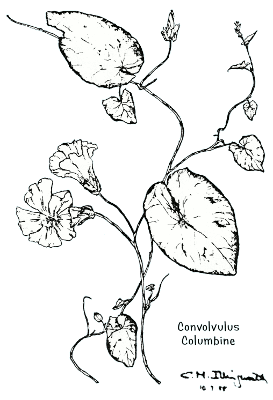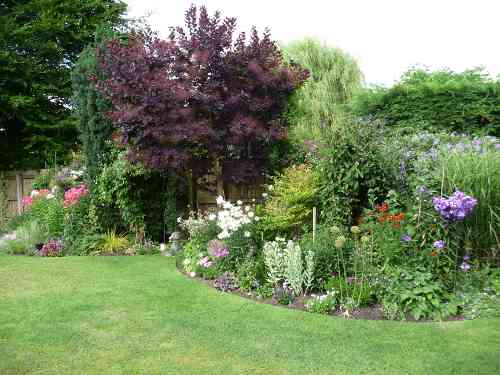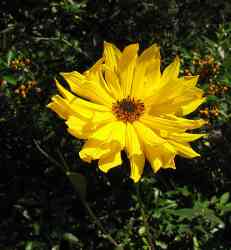Newsletter
Autumn 2011

Newsletter |
 |
Who would have thought that, after a very disappointing summer, I would be writing this at the beginning of October with temperatures in the high 20s? The warmth has made the last few tomatoes in the greenhouse ripen after I thought they would have to be made into chutney and the chillis are all ripening well, but the ash leaves from the trees just outside my back fence are already yellow and falling, no doubt in part due to the dry weather. My friend in Scotland emails me about having 200% of their annual rainfall this year and what havoc high winds and low temperatures have wreaked in her garden so, although I wouldn't have minded some of her rain, I won't complain.
I have just spent the hour before lunch weeding and generally tidying up and made two pleasant discoveries – a small plant of Sedum ‘Purple Emperor’ which has seeded about a yard from the parent plant and some autumn scillas which I thought had vanished for ever. The sedum came from Beth Chatto's nursery when we were on the first HPS holiday in East Anglia and the scilla was from Rob Cole's garden in Feckenham. I admired it as we were looking around at one of our coffee mornings and, just as we were leaving, he came up to me and handed me a few. I planted them and waited – and waited – to no avail, so came to the conclusion that they had vanished. They were obviously biding their time because they have now reappeared and I hope will increase over the years. The real star of the show has been Aster frikartii ‘Monch’ which has flowered for months and months and is still going strong. A big disappointment has been the veronicastrum I bought at Knoll Gardens on our Dorset HPS holiday. It continually flops unless watered almost daily and is looking very sickly. With a small garden everything has to earn its place so I shall speak very severely to it and tell it to pull its socks up or it goes. It's particularly galling having seen some beauties at Marchants Nursery on our Kent and Sussex HPS holiday this year.
Autumn is a time for reflecting on the past gardening year and deciding on changes. Several plants need moving or dividing, the tubs and troughs will soon need summer bedding removed and replacing with bulbs, the houseplants have already been moved back indoors after their summer holiday outside and the less hardy plants will have been put into the greenhouse before the end of the month. Dahlias too will be lifted and spend the winter on the top of the spare bedroom wardrobe as my soil is too cold to keep them in the borders.
To finish on a more serious note: please consider standing as a committee member at our next AGM. Duties need not be onerous – we have very few committee meetings in the year, usually before a monthly meeting, and we really need some fresh blood as some of the old guard stand down. Our Group is a very lively one and it would be a shame to see some of our activities curtailed because of a lack of helpers. If you are at all interested, please speak to me or David Pollitt at any time.
Happy gardening.
Subscriptions to the Group become due on 1st January 2012 and can be paid either on the door at a meeting or by post to my address at Half Acre, Main Street, Worcestershire, WR11 7XB. Cheques to be made payable to ‘HPS Worc's Group’. The sub remains the same at £12.50 and admission to the meetings is free. It would be helpful if you are able to give me a post-dated cheque at our December 2011 meeting. This would ease the burden on the door in January 2012. Remember membership of the Group is conditional on being a member of the national Hardy Plant Society.
There are a lot of Thank You's this edition: to Martie for the cover drawing; Leila, Wendy and Ann Hooper for photos; Leila again for printing the colour pages and all those of you who have contributed articles. We have a lot of reports about what we've done this summer, but very few about plants and our gardens. I like reading those - they're a great mix of knowledge, joy at plants doing well and some rueful admission of things not going to plan. Congratulations go to Jackie Davies whose article 'Blue and White' from the autumn 2009 edition appears in the latest ‘Cornucopia’. To have read about the blue and white bed in her garden added extra interest at her coffee morning.
You'll probably have noticed that the logo and the font have changed. Now that the national Society is using its new logo and style, including font, it's asking that, where possible, the rest of us do too. The font, which Colin is already using on our new-look website, is Arial which I've used here. I hope you'll find it satisfactory.
The AGM papers appear in this edition, and the copy date for the spring 2012 newsletter, available at the March meeting, is 11 February.
‘Have you lost much?’ A question posed by neighbours, friends and fellow Hardy Planters in the days following the severest winter weather for years, and, relating, of course, to the loss of plants. At first, pessimism had taken hold, and I envisaged much destruction, but with the arrival of milder conditions, a careful survey showed that losses were not nearly as bad is I had feared, and were mostly confined to evergreen shrubs.
So, what had we lost? A Pittosporum tenuifolium, which at some 8ft high had ambitions to become a fully grown tree. I left the skeleton in the ground as it provided a splendid climbing frame for an adjacent Clematis texensis ‘Princess Diana’. A small variegated pittosporum, never as robust as the species, also died. Two Coronilla valentinasubsp glauca ‘Citrina’, purchased from Bob Brown four years ago, and sited under the canopy of our beech tree, soon showed signs of distress and died on us. An Indigofera heterantha, admittedly not a very robust specimen, succumbed to the ravages of the prolonged frost, as did a nearby Drimys lanceolata. We were sorry to lose the drimys as it is a handsome shrub with attractive leaves and stems.
The strap-like leaves on a large Cordyline australis ‘Atropurpureum’ all withered, so, with some difficulty, as the roots went down some way, I dug it out. With hindsight if I had cut it down it might well have sprouted from the base. Anyway it had reached its 'sell-by' date. A small Yuccarostrata, planted the previous autumn, also did not survive. With two phormiums I spent some time removing dead and damaged leaves, but they still looked so unsightly that I dug them out and consigned the remains to the green wheelie bin. I have vowed not to plant phormiums in the borders again, as the strong fibrous leaves hang down and thrash about in the wind, zapping any plant within range. The best place for them is in isolation in a large pot.
Five of our clematis collection would appear to have gone to the plant heaven, although I think this is more likely to be due to causes other than the winter weather. Dryness at the root is the most likely one; a weak plant in the first place and too much sun on exposed root areas are others. I say 'would appear' for clematis can be unpredictable plants, and, on occasion, play dead, only to shoot up again the following year. Patience is needed where they are concerned.
So, that's it. Excluding the clematis, just ten plants, which, as a percentage of the whole garden, is very small.

Alan's garden in July 2009
Then there are the plants which have suffered but survived. The bay looked a sorry sight, more brown than green, and after rather ineffectually snipping away at the damage I took out the heavy duty loppers and cut it to the ground. Within about two weeks a ring of healthy shoots had sprouted around the original stem, and these are now (August) some 3ft tall and growing strongly. Similarly with an olearia - a daisy-bush, with signs of frost damage, I cut this well down and it has developed new growth low down. A fatsia looked a sorry sight with blackened leaves, but cutting it down has had the effect of re-juvenating it and it has produced a splendid new crop of healthy, soft-green fingered leaves. A Rhamnus variegata also showed signs of being in terminal decline by shedding most of its leaves, but then rallied and is once again a handsome shrub.
You might well ask here, why don't you take protective measures, such as the use of fleece, with plants known to be on the borderline of hardiness? In my view plants have to take a chance in the open garden, and, if they are particularly valued, should be grown in pots and kept in the greenhouse over winter. Putting protection around plants is not as easy as it is made out to be. I remember once watching 'Gardener's World', where they were wrapping up a banana (Musa) like a parcel, with straw and hessian, for the winter. I thought, what a time-consuming performance for a tree that isn't all that attractive in the first place, and then, for the next 4-5 months you are left looking at this strange, alien, furled umbrella-like object in the garden. Not for me.
On the plus side, the severe weather appears to have positively benefited the herbaceous plants. The spring bulbs have put on a wonderful show this year and the border perennials are all looking good. In this part of the country, drought has recently been something of a worry, but that's another story.
Twenty or so years ago my father gave me a copy of 'Gardening Letters to my Daughter' by writer Anne Scott-James, who lived in London and Berkshire, but gardened in Berkshire. She writes, in a piece titled 'September Pink' that she 'arrived at the cottage [her Berkshire home] wondering whether I would find the garden yellow with the last of the summer daisy plants or red with berries and turning leaves. It is neither. Most of the flowers are a tender pink. One forgets that a band of pink separates August and October.'

In our garden of two halves where the house separates front and back entirely, the front is overwhelming yellow and orange: Rudbeckia 'Goldsturm' and Heliopsis helianoides with rowan and pyracantha berries above. The heliopsis, started from seed a very long time ago, walks about: despite its height it marches to the front of the border if given a chance - at least it's easy to pull out. But I've finally got Verbena bonariensis to grow in among and the caryopteris, though much reduced after last winter, is showing its haze of grey/blue. But there is pink, too: cyclamen hederifolium under the tree paeony and in other spots open in the summer. They walk about too, to the detriment of easy grass cutting, but who can resist them? or their stems curled up ready for the seeds to walk about even further?
Looking down on the back garden from the kitchen the centre is pink: Sedum ‘Autumn Joy’, a pink chrysanth from my father's garden, Salvia nemorosa ‘Pustzaflamme’ (fading but still dusty pink), Phlox paniculata white with a pink eye, Eupatorium purpureum, Clerodendron bungei; Nerine bowdenii just starting to flower and Chrysanthemum ‘Clara Curtis’ for later. The Cornus florida is still green though it has its reddish-pink fruits. But beyond are glimpses of a bright purple/magenta aster, much-loved Dahlia ‘Bishop of Llandaff’ and more rudbeckia. And holding together the soft and the bright, the different colours, as it's done all summer, is Persicaria ‘Red Dragon’, a plant I've liked since first meeting it at Pershore College, but hadn't realised its tremendous value in our garden until this year. Thank you, to the member who brought this plant to the donated table at one of our meetings.
So, ‘band of pink’? Yes, partly, and much appreciated among the bright and before the leaves turn and fall.
Becky Dale is working with Heritage Travel Ltd with the idea of arranging a trip to Dublin from 2 to 6 July. Suggested gardens include, among others, The Dillon Garden, Corke Lodge Garden near Bray, Carmel Duignan's Garden, the Powerscourt Estate, Rathmichael Lodge, Mount Salem, Hunting Brook and June Blake’s Garden. Visits to Dublin Castle and Malahide Castle as well as an orientation tour and some free time in Dublin are also planned. The likely cost of the tour, without flights, is £500.
If you might be interested in joining the tour, please contact Becky.